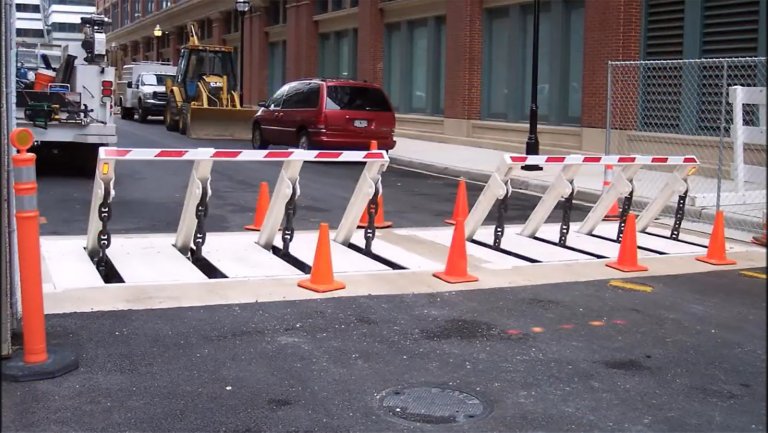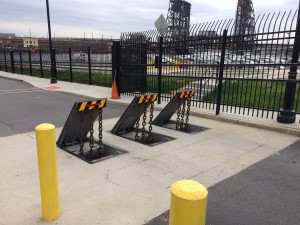Not known Details About Wedge Barriers
Table of ContentsNot known Facts About Wedge BarriersThings about Wedge Barriers


18 may be done quicker, easily, and price properly. FIG. In certain personifications, the anchor 30 may be a steel structure including plates, light beams(e. g., I-beams ), and/or other frameworks that are secured within the structure 14, which may be concrete. At the surface area 12, a top side 28 of the anchor 30 might go to least partly revealed
, thus making it possible for the attachment of the obstacle 10 to the support 30. g., threaded holes)in several beam of lights or plates of the support 30 may be subjected to the surface area 12. In this fashion, bolts 32 or various other mechanical fasteners may be made use of to safeguard the obstacle 10 to the support 30. As the barrier 10 is installed to the surface area 12 of the foundation 14, collection of debris and various other product below the barrier might be lowered, and components of the bather 10 may not be subjected to listed below quality environments. As suggested by referral character 52, the training mechanism 50 includes components disposed underneath the wedge plate 16. As an example, the parts 52 below the wedge plate 16 may consist of an electromechanical actuator, a cam, several webcam surface areas, etc. Additionally, the lifting system 50 includes a spring assembly 54
The springtime pole 58 is paired to a web cam(e. g., web cam 80 received FIG. 4) of the training system 50. The springs 60 disposed regarding the spring rod 58 are held in compression by springtime sustains 62, consisting of a taken care of spring assistance 64. That is, the fixed spring assistance 64 is dealt with about the foundation 14 et cetera of the bather 10.
Wedge Barriers for Dummies
The remaining force applied to
the cam camera deploy release wedge plate 16 may be provided given an electromechanical actuator 84 or other actuator. The spring setting up 54 and the actuator 84(e. Wedge Barriers. g., electromechanical actuator)might run with each other to translate the webcam and lift the wedge plate 16.
As mentioned above, the spring assembly 54 exerts a continuous force on the webcam, while the electromechanical actuator might be managed to apply a variable pressure on the web cam, therefore enabling the lifting and lowering( i. e., deploying and retracting )of the wedge plate 16. In certain embodiments, the continuous force applied by the spring assembly 54 may be flexible. g., electromechanical actuator) is impaired. As will certainly be valued, the springtime setting up 54 might be covered and shielded from particles or various other components by a cover plate(e. g., cover plate 68 displayed in FIG. 4) that might be considerably flush with the raised surface area 38 of the structure 14. As pointed out above, in the deployed position, the wedge plate 16 offers to obstruct accessibility or traveling past the barrier 10. As an example, the barrier 10(e. g., the wedge plate 16 )might obstruct pedestrians or vehicles from accessing a residential or commercial property or pathway. As Extra resources talked about over, the barrier 10 is attached to the anchor 30 protected within the foundation 14,

front brackets 71. Because of this, the link assemblies 72 might pivot and revolve to enable the collapse and expansion of the affiliation assemblies 72 during retraction and deployment of the bather 10. The linkage assemblies 72 reason motion of the wedge plate 16 to be limited. If a lorry is taking a trip in the direction of the released wedge plate 16(e. For example, in one situation, the safety legs 86 may be expanded throughoutmaintenance of the barrier 10. When the security legs 86 are deployed, the security legs 86 support the weight of the wedge plate 16 against the surface 12. Consequently, the lifting mechanism 50 may be deactivated, serviced, removed, replaced, and so forth. FIG. 5 is partial viewpoint sight of an embodiment of the surface-mounted wedge-style barrier 10, highlighting the webcam 80 and the webcam surfaces 82 of the lifting system 50. Particularly, two web cam surface areas 82, which are referred to as lower web cam surface areas 83, are positioned listed below the camera 80. The have a peek at these guys lower web cam surface areas 83 may be fixed to the surface area 12 (e. For example, the lower camera surfaces 83 and the placing plate 85 may form a solitary piece that is safeguarded to the anchor 30 by screws or various other mechanical fasteners. Additionally, two cam surface areas 82, which are referred to as top webcam surface areas 87, are positioned over the webcam 80 and coupled to (e. In various other embodiments, interfering layers or plates may be placed between the surface 12 and the reduced webcam surface areas 83 and/or the wedge plate 16 and the upper camera my site surfaces 87 As stated over, the cam
80 converts along the webcam surface areas 82 when the wedge plate 16 is lifted from the withdrawed position to the released placement. Furthermore, as stated above, the springtime setting up 54 (see FIG. 3 )may supply a force acting on the web cam 80 in the direction 102 through springtime pole 58, which may minimize the pressure the electromechanical actuator 84 is required to apply to the webcam 80 in order to activate and lift the wedge plate 16. 1 )to the deployed setting(see FIG. 4). As revealed, the cam 80 consists of track wheels 104(e. g., rollers), which call and translate along the webcam surface areas 82 throughout operation.